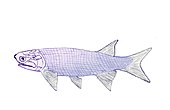Besania
| Besania Temporal range:
| |
|---|---|

| |
| Fossil of Besania sp. at Civic Museum of Fossils of Besano | |
| Scientific classification | |
| Domain: | Eukaryota |
| Kingdom: | Animalia |
| Phylum: | Chordata |
| Class: | Actinopterygii |
| Subclass: | Neopterygii |
| Genus: | †Besania Brough, 1939 |
| Type species | |
| †Besania micrognathus Brough, 1939
| |
| Other species | |
| |
Besania is an extinct genus of prehistoric marine ray-finned fish[1] that lived during the Anisian and Ladinian ages of the Middle Triassic epoch in what is now southern/southeastern Switzerland and northern Italy.[2] Fossils were recovered from the Besano Formation of Monte San Giorgio area (Swiss-Italian borderland)[3] and the Prosanto Formation of canton Graubünden, Switzerland.[4]
Initially considered a perleidiform or luganoiiform, it is now thought to be an indeterminate "halecostome" or basal neopterygian.[4] There are two known species, Besania micrognathus (type species) and B. schaufelbergerae. Both are quite small (31 mm (1.2 in)–44 mm (1.7 in) in standard length).
The genus is named after the Italian town of Besano, Lombardy, near Monte San Giorgio.
See also
[edit]References
[edit]- ^ a b Sepkoski, Jack (2002). "A compendium of fossil marine animal genera". Bulletins of American Paleontology. 364: 560. Archived from the original on 2011-07-23. Retrieved 2009-02-27.
- ^ "PBDB". paleobiodb.org. Retrieved 2024-03-15.
- ^ Bürgin, Toni (1992). "Basal ray-finned fishes (Osteichthyes; Actinopterygii) from the Middle Triassic of Monte San Giorgio (Canton Tessin, Switzerland). Systematic palaeontology with notes on functional morphology and palaeoecology". Schweizerische Paläontologische Abhandlungen. 114: 1–164.
- ^ a b Herzog, Annette; Bürgin, Toni (2005). "A new species of the genus Besania Brough 1939 from the Middle Triassic of Canton Grisons (Switzerland) with a discussion of the phylogenetic status of the taxon". Swiss Journal of Geosciences. 98: 113–122. doi:10.1007/s00015-005-1169-2. S2CID 91122544.
- Prehistoric neopterygii
- Prehistoric ray-finned fish genera
- Enigmatic ray-finned fish taxa
- Middle Triassic fish
- Triassic bony fish
- Triassic fish of Europe
- Middle Triassic animals of Europe
- Triassic Italy
- Triassic Switzerland
- Fossils of Italy
- Fossils of Switzerland
- Anisian genus first appearances
- Ladinian genus extinctions
- Fossil taxa described in 1939
- Prehistoric ray-finned fish stubs
- Triassic fish stubs





